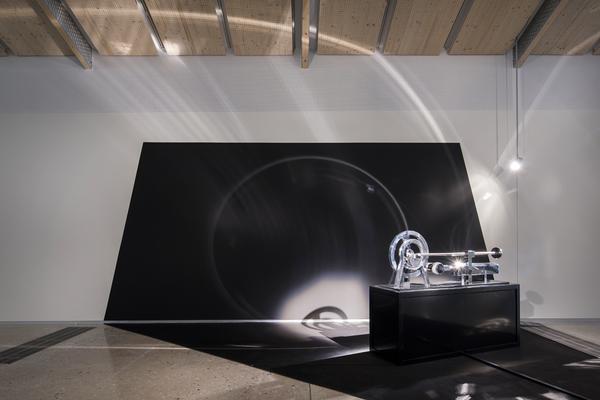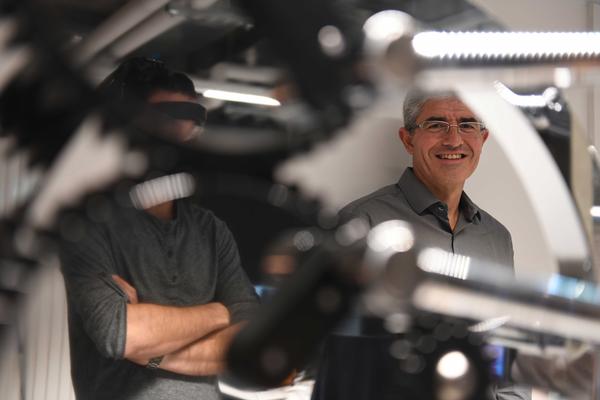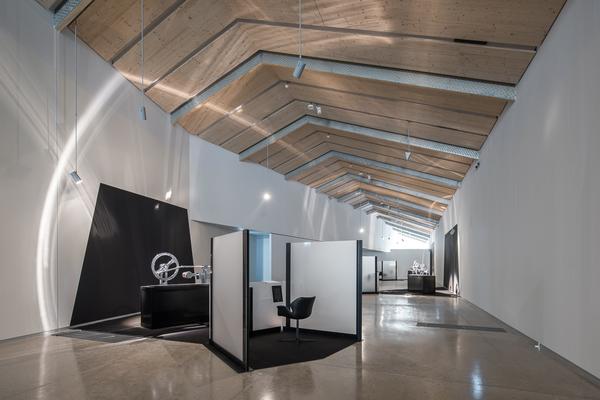Embark on a cognitive revolution at EPFL

© 2017 EPFL / Hillary Sanctuary
Use your brainwaves to control the workings of a machine and contribute to science at EPFL ArtLab’s next art-science exhibition, "Mental Work" from October 27th – February 11th, 2018.
EPFL ArtLab inaugurates the world's first cognitive symbiosis experiment, open to the public on October 27th, in the form of an art-science exhibit called Mental Work, and it’s literally thought-provoking.
From a technical standpoint, thought is at the core of the Mental Work exhibit. Visitors have the opportunity to experience what it’s like to control machines using thought alone via brain-machine interfaces, and it requires a fair share of concentration. Plus, anonymized brainwave data will be made available to the scientific community to improve cognitive interfaces.
Mental Work also questions the relationship between human and machine, and how this relationship will evolve with technological advances. It juxtaposes the industrial revolution against the possibly imminent cognitive revolution in which human and machine are in symbiosis.
“We would like to generate a societal debate,” says José Millán, EPFL neuroengineer and co-founder of the project. “This cognitive revolution, which is about to come, may have different shapes. Which is the shape that people would like to see? Which is the place of brain-machine interfaces, if any, in the future cognitive society that we are moving towards?”

© 2017 EPFL / Mental Work / Adrien Barakat
EPFL technology deciphers brainwave activity for Mental Work
At EPFL, Millán develops brain-machine interfaces, essentially robotic systems that perform a subject’s intention. These systems require technology that detects and decodes the electrical activity of the brain in order to decipher the intended task.
Applications range from assisting the physically challenged with intact cognitive ability, to improving our daily interactions with machines, or simply preventing one’s cognitive abilities from declining prematurely.

© 2017 EPFL / Hillary Sanctuary
This deciphering of a subject’s intention based on the brain’s electrical activity is possible due to the organized firing of neurons in the brain. The way the brain processes information is far from being understood, but the electrical activity can be measured, non-invasively, by placing electrodes on the head. Specific thoughts provoke different patterns of electrical activity, but the signal is noisy. Millán develops algorithms that sift through the noise to detect these patterns, and he has provided this technology to the Mental Work exhibit.
“Mental Work is an art exhibit where we will be running a large-scale experiment on brain-machine interfaces, meaning that people will be able to control machines by modulating their brainwaves,” continues Millán. “All the [anonymized] data that we will acquire will be made available to the brain-machine-interface scientific community, in order to advance the field through the analysis of brainwave data.”
A state-of-the-art helmet, fully equipped with electrodes, is provided to visitors at Mental Work. The visitor must imagine either closing both hands – without actually closing them – or simply relaxing both hands. An estimated 15 minutes of training is required in order for the EPFL algorithms to detect the two patterns, closed hands or relaxed hands. These thoughts can then be used as commands to operate a machine via a computer.
The Mental Work Factory
The machines at Mental Work look like a science-fiction rendition of historical train wheels, equipped with apparent gears and moving parts, all of which are chromed to reflective perfection. The machines were imagined by American artist, experimental philosopher and co-founder of Mental Work, Jonathon Keats, and realized by dedicated EPFL technicians of the ATMX workshop, in collaboration with industrial partners in the Lausanne region.
“The industrial revolution was a dangerous period in history, literally dangerous for the laborer who might lose a hand while not paying attention,” explains Keats. “Now we are in the cognitive revolution and the stakes are potentially higher. Today, that won’t happen because you are not in touch with the machine in any physical way. Instead, you may lose your mind.”
This contrast between the industrial and cognitive revolutions gave rise to the Mental Work exhibit, a “factory” where the visitor is a “worker” providing labor in the form of thought.
“At the Mental Work Factory, we are asking workers to come and engage in machines using only their brain-power,” says Mental Work co-founder and chief business officer Michael Mitchell. “In the industrial revolution, man’s hands were replaced by machines. Now we have the real risk that man’s brain will be replaced by smarter and smarter machines. We want to bring man and his brainpower back to the center of the technology, and that’s why we are using brain-computer interfaces.”

© 2017 EPFL / Mental Work / Adrien Barakat
Mental Work, a Swiss experience
“ArtLab’s primary mission is to be a laboratory for exhibition experiments,” says EPFL Artlab’s Head of Content, Luc Meier. In this sense, Mental Work is truly an art-science experiment. It was developed and built at EPFL in collaboration with José Millán, Jonathon Keats and Michael Mitchell as well as the Lausanne-based Paperboy agency. The exhibit uses EPFL brain-machine technology and aesthetically stunning machines built with the help of EPFL’s fabrication workshops and engineers.
Meier continues, “ The project was made possible thanks to a collaboration with the School of Engineering’s Technical Workshop Platform, in particular its Atelier de l’Institut des matériaux ATMX, as well as a close local network of interaction designers and coders. The project was entirely funded by EPFL, the Swiss National Science Foundation and Swiss funds.”
Resitration via the website www.mentalwork.net is necessary in order to visit the exhibit from October 27th until November 12th.